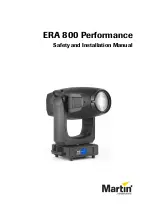
Approved Document No. DAU0000050 Rev
2
• Page 5
Maximum area coverage
The maximum coverage provided by the loop system is 50m
2
(i.e. a room up to 7 x 7 metres
in size). Longer rooms can be covered provided width x length measurements do not exceed
50 metres.
Trial loops
Always run a trial loop and test to evaluate performance by listening to the signal with
either a hearing aid or a dedicated loop test receiver, such as SigNET’s RxTI (loop testing
equipment can be ordered using the ancillary order form attached). Refer to our dedicated
‘system set-up and testing’ section on pages 8 and 9 for further details.
Audio sources without output sockets
Some older televisions and other audiovisual appliances may not have a suitable output
socket for direct connection to the loop amplifier. NEVER attempt to make your own
connections by opening the appliance as high voltages WILL be present. Instead, place a
microphone next to the audio source in question.
Ventilation
The amplifier can become quite warm during normal operation so the airflow around it
must not be restricted. Ensure that the four rubber feet supplied in the accessory pack are
attached to the bottom of the unit as shown on page 7.
The ‘isolation’ issue
When a hearing aid user switches his or her hearing aid to the ‘T’ position, its on-board
microphone is switched off and the only noise that can be heard is the loop signal. If an
induction loop amplifier is connected to just one sound source, such as a television, some
hearing aid users (but not all) have said the lack of background noise makes them feel
isolated. This issue can be overcome by positioning a microphone where it will convey
background noise and pick up general conversation. (A maximum of two microphones can
be connected to the DL50, one is supplied as standard, if you require another you can order
one using the ancillary order form attached).
Overspill and ‘cross-talk’
The signal generated by the loop will radiate outside as well as inside the loop. If there are
any other loop systems in close proximity, overspill such as this may lead to ‘cross-talk’
(signals from different loops merging into one). Although not usually a problem in
domestic applications, special designs of loop can be implemented to help reduce the
overspill field. In the unlikely event of you encountering such problems, contact your
vendor for assistance.
Hints & tips
Approved Document No. DAU0000050 Rev
2
• Page 8
With all system connections in place (see
pages 6 & 7), apply power to the amplifier
and check its green ‘power on’ indicator is lit.
System set-up and testing
Always run a trial loop to ensure correct operation. Only when you are happy with the
sound quality should you permanently fix the loop using tape, cable clips or a staple gun.
Turn on the system’s audio input source
(usually a television and/or a microphone)
and ensure it is producing an audio signal.
Note, SCART outputs have a fixed level signal
and altering the TV’s volume control will not
affect this.
1
2
3
Using the flat-headed screwdriver
supplied, turn the amplifier’s input signal
level control clockwise until its input signal
indicator begins to flicker. This flickering
is associated with peaks in the audio
signal - if permanently lit, the signal will be
distorted. Re-adjust the control accordingly.
Set the loop field
strength by turning the
loop signal control in small
increments. After each slight
adjustment, check the audio
signal using a hearing aid or
induction loop test receiver
whilst standing in the centre
of the loop/room. Repeat
until an acceptable signal
level is received.
4
5
When you are satisfied with the signal
in the centre of the loop, move around the
room to ensure coverage is consistent
throughout. Pay particular attention to areas
where the hearing aid user is likely to sit.
Next, if possible with the hearing aid user
in position, set the amplifier’s tone and
microphone controls to suit their personal
preference following steps 6 and 7.
























